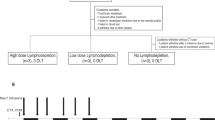Abstract
Lymphodepleting conditioning regimens are essential for the success of CAR-T cell treatment. Their importance in the proliferation and persistence of CAR-T cells has become clearer in the recent years. The suggested mechanisms are described in Table 25.1 and include the effects on immune cells and cytokines, creating an environment for optimal functioning and increasing the peak of expansion of the infused CAR-T cells (Neelapu 2019).
You have full access to this open access chapter, Download chapter PDF
Similar content being viewed by others
Lymphodepleting conditioning regimens are essential for the success of CAR-T cell treatment. Their importance in the proliferation and persistence of CAR-T cells has become clearer in the recent years. The suggested mechanisms are described in Table 25.1 and include the effects on immune cells and cytokines, creating an environment for optimal functioning and increasing the peak of expansion of the infused CAR-T cells (Neelapu 2019).
The addition of fludarabine to cyclophosphamide has been important in increasing the efficacy of CAR-T cell treatment and is currently the most commonly used combination (Turtle et al. 2016). In the applied conditioning regimens, the dosing of fludarabine is relatively consistent, with the use of 25–30 mg/m2, given on 3 sequential days, but the dosing of cyclophosphamide differs in days and intensity. A “higher intensity” cyclophosphamide dosing regimen seems to be preferred (Hirayama et al. 2019). However, even with the best lymphodepletion regimen, some patients fail to develop a favourable cytokine profile, suggesting that the host biological response to lymphodepletion chemotherapy is important (Hirayama et al. 2019). Most conditioning regimens can be given on an outpatient basis.
In Hodgkin lymphoma treated with anti-CD30 CAR-T cells, bendamustine has been used as conditioning regimen, but in this disease, the addition of fludarabine to the regimen has also been shown to increase antitumour responses. Whether an even more intensive regimen is needed in solid tumours is currently unknown.
The timing of the conditioning regimen is typically within a week before the planned infusion, with a minimum of 2 resting days to avoid a negative impact of chemotherapy on the infused cells. If, after the start of the conditioning regimen, the patient cannot receive CAR-T cells, most protocols allow a waiting time of 2–4 weeks before a new conditioning regimen must be started. In other protocols, conditioning regimens are not given if the absolute lymphocyte count is below 200 cells/μL.
The negative effects of conditioning regimens include pancytopenia and prolonged immune suppression and add to the enhanced risk of (viral) infections seen after CAR-T cell treatment. In addition, fludarabine can induce fever, neurotoxicity, cyclophosphamide haemorrhagic cystitis, and pericarditis, and both drugs may increase the risk of secondary malignancies.
-
An effective lymphodepleting regimen increases the proliferation and persistence of CAR-T cells.
-
Fludarabine seems essential and is typically used with cyclophosphamide.
References
Hirayama AV, Gauthier J, Hay KA, et al. The response to lymphodepletion impacts PFS in patients with aggressive non-Hodgkin lymphoma treated with CD19 CAR-T cells. Blood. 2019;133:1876–87.
Neelapu SS. CAR-T efficacy: is conditioning the key? Blood. 2019;133:1799–800.
Turtle CJ, Hanafi L-A, Berger C, et al. Immunotherapy of non-Hodgkin’s lymphoma with a defined ratio of CD8+ and CD4+ CD19-specific chimeric antigen receptor–modified T cells. Sci Transl Med. 2016;8:1–12.
Author information
Authors and Affiliations
Corresponding author
Editor information
Editors and Affiliations
Rights and permissions
Open Access This chapter is licensed under the terms of the Creative Commons Attribution 4.0 International License (http://creativecommons.org/licenses/by/4.0/), which permits use, sharing, adaptation, distribution and reproduction in any medium or format, as long as you give appropriate credit to the original author(s) and the source, provide a link to the Creative Commons license and indicate if changes were made.
The images or other third party material in this chapter are included in the chapter's Creative Commons license, unless indicated otherwise in a credit line to the material. If material is not included in the chapter's Creative Commons license and your intended use is not permitted by statutory regulation or exceeds the permitted use, you will need to obtain permission directly from the copyright holder.
Copyright information
© 2022 The Author(s)
About this chapter
Cite this chapter
Mohty, M., Minnema, M.C. (2022). Lymphodepleting Conditioning Regimens. In: Kröger, N., Gribben, J., Chabannon, C., Yakoub-Agha, I., Einsele, H. (eds) The EBMT/EHA CAR-T Cell Handbook. Springer, Cham. https://doi.org/10.1007/978-3-030-94353-0_25
Download citation
DOI: https://doi.org/10.1007/978-3-030-94353-0_25
Published:
Publisher Name: Springer, Cham
Print ISBN: 978-3-030-94352-3
Online ISBN: 978-3-030-94353-0
eBook Packages: MedicineMedicine (R0)




